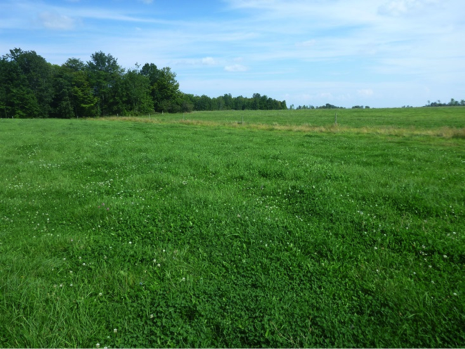by Kitty O’Neil and Mike Hunter, Regional Field Crops and Soils Specialists
We’ve discussed pasture grasses, legumes, pasture weeds and management ideas for pasture improvement on these pages many times before. All good topics. When you call to mind pasture weeds though, I’d bet you picture milkweed, goldenrod, a couple different types of thistles and maybe bedstraw. These are pesky and important weeds in many pastures, but there are other, sneakier weeds that may escape your attention. These sly and mischievous weeds require closer inspection and a bit more scrutiny to figure out.
Ideally, pastures are dense, perennial sods consisting of mixtures of high-yielding, palatable grasses and legumes. In reality, most pastures do not quite match this perfect ideal. Weeds are normally present in some number, ranging from insignificant to seriously problematic, depending on management and history. Weed density within a pasture can change over time, and can vary from one area to another within a pasture. You may notice, in your own pastures or hay fields, that weeds are often not distributed uniformly, but rather that some plant species are concentrated on knolls, along the woods, in wet spots, or in high traffic areas.

Let’s turn our attention to some particularly sneaky weeds that are often, but not always, found in lower, wetter areas of the pasture – the sedges and rushes. I’m referring to them as ‘sneaky’ because they’re a bit harder to spot in the pasture. They look a lot like grasses to an amateur observer, but that is about as far as the similarities extend. As a group, grasses consist of a jointed stem with a few tillers, long and slender leaves with parallel veins. They range in height from turf to giant bamboo. Grasses may be annual or perennial but all have their growing points near the soil surface, so they can survive repeated mowing or grazing. Grasses reproduce via seed or underground structures. Most of the hay and pasture grass species (bluegrass, orchardgrass, timothy, fescues, reed canarygrass, etc.) are quite palatable and produce moderate to high yields.
Sedge and rush species also have long slender leaves but occupy completely different branches on the evolutionary tree of life than grasses. Sedges and rushes are perennials that livestock typically avoid, finding them unpalatable. There are well over 1000 different sedge species, but the most common sedge found in Northeast pastures and hayfields is Yellow Nutsedge. Yellow nutsedge is noticeable for its pale green color, spiky flowers and underground tubers, but its most distinctive feature is its stem. If you compare the lower stems of sedges and grasses, you’ll discover that sedges typically have triangular stems without nodes while grasses have round or flattened stems with nodes. This key difference is the reason for the memorable phrase “sedges have edges, but grasses have knees.” Sedges reproduce by underground tubers and rhizomes.
Rushes are short plants that resemble grasses and sedges and are also found in lower, wetter areas of a pasture or hayfield, although rushes may grow in drier or compacted areas too. The unique feature of rushes is their 3-petal, lily-like flowers. In fact, botanists refer to rushes as “lilies turned to grass” to help them remember their distinctive flowers. Rushes reproduce by vegetative rhizomes or by seed. The tough, wiry, round stems of rushes are also avoided by livestock who generally do not find them palatable. In the Northeast, the most common of the rushes is Slender Rush.
Nutsedge and rushes might be most noticeable as animals are finished with a pasture or paddock. The livestock will have eaten grasses and other appealing plants, leaving behind patches of Yellow Nutsedge and Slender Rush. It is disappointing to see large, uneaten areas of low-yielding, unpalatable pasture, but biological features of rush and sedge make them difficult to control. Their underground reproductive structures make mowing or clipping ineffective as a means for removal, but this strategy can slow their spread, if it is timed before flowering. Herbicide options for these two weeds are limited, but Permit and Yukon have recently had hay and pasture applications added to their labels. They may be used on yellow nutsedge in grass pastures with no grazing restriction for lactating or non-lactating animals. If the field is not too wet for machinery, suitable grasses or legumes can be overseeded with a no-till drill or, as a more drastic measure, the sod may be killed and soil can be tilled for replanting of appropriate grasses and legumes. Often though, the sedges and rushes occupy areas that may be difficult to access with tractor equipment. In this case, the field could be tiled for better drainage if that option is economically advantageous. Legume species such as red or white clover can be frost-seeded in the spring to try and introduce more desirable species, but the rush and sedge species will likely persist. Sedge and rush weeds take a keen eye to notice, but their impact can be just as important as thistles or milkweed or goldenrod in a pasture or hayfield. Their presence reduces overall productivity of the field and presents a challenge to the farm manager.
Additional resources:
- Uva, Neal and DiTomaso, Weeds of the Northeast, Ithaca, NY: Cornell University Press, 1997.
- Kersbergen, R. 2004. Bulletin #2491, This Old Hayfield: A Fact Sheet on Hayfield Renovation. U Maine Extension.
- Specification Guide Sheet For Pasture and Hay Planting (512), Vermont NRCS http://www.nrcs.usda.gov/Internet/FSE_DOCUMENTS/nrcs144p2_016364.pdf.
- Yukon (http://www.gowanco.com/products/yukon.aspx) and Permit (http://www.gowanco.com/products/permit.aspx) herbicides, Gowan Company.
For more information about field crop and soil management, contact your local Cornell Cooperative Extension office or Kitty O’Neil, Regional Field Crops and Soils Specialist, Cornell University Cooperative Extension, 315-379- 9192 x253; kao32@cornell.edu.

